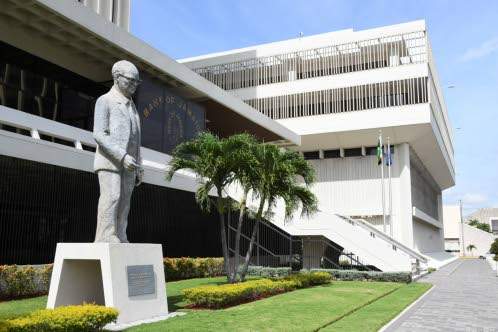increase within the range of 13.0 per cent to 15.0 per cent, which is much higher than the 9.0 per cent recorded over the past year. The BOJ said the worsening unemployment condition is predicated on the adverse impact of the novel coronavirus. The BOJ’s projections are contained in its Quarterly Monetary Policy Report (QMPR) for November, which was released last Thursday. In its QMPR, the BOJ reported that the employed labour force is projected to decline (year over year) at an average rate of 0.5 per cent per quarter, even while the labour force is projected to decline. The anticipated increase in unemployment, particularly over the next four quarters is greater than the previous projections made by the BOJ. The QPMR states that, “the expected increase in unemployment is anticipated mainly in tourism, construction, transport and wholesale & retail industries.” UNEMPLOYMENT RATE JUMPS 4.8% The unemployment rate at July 2020 increased to 12.6 per cent, which was 4.8 percentage points above the rate recorded as at July 2019. While there was an increase in the unemployment rate at the same time there was a decline of 10.8 per cent (135,800) in the employed labour force. The increase in the unemployment rate occurred in the context of a reduction of 6.0 per cent (81,200) in the labour force. The number of unemployed persons increased by 51.2 per cent, while the labour force participation rate fell by 4.0 point to 61.3 per cent. The Jamaican economy is estimated to have contracted in the range of 10.0 to 13.0 per cent for the September 2020 quarter, a slower pace of contraction compared to the 18.4 per cent decline recorded for the June 2020 quarter. However, this contraction is much greater relative to the previous projection, which was for a reduction of 8.0 per cent. COVID-19 CAUSING ECONOMIC CONTRACTION The estimated decline for the quarter was due mainly to the continued adverse impact of the novel coronavirus on the economy and measures implemented to contain its spread. Consequently, only government services and agriculture, forestry & fishing are estimated to have grown. The contractions in the economy were concentered mainly in the hotels & restaurants, other services, mining & quarrying, wholesale & retail and construction sectors. This is worse than the previously projected declines for the review quarter in the areas of construction, wholesale & retail trade, electricity & water, manufacture and finance & insurance. In contrast, a slower pace of decline for hotel & restaurants as well as higher growth in agriculture, forestry & fishing are estimated. There was a downward revision to construction, due to reductions in all sub-industries, particularly for building construction and civil engineering. As it regards civil engineering, the downward revision is due to lower spending on road rehabilitation works. Manufacture is estimated to have declined faster due to reductions in both food production and petroleum refining. STRONG DECLINE PROJECTED IN WHOLESALE & RETAIL TRADE According to the BOJ, the stronger decline in wholesale & retail trade is predicated on the estimated performance of the manufacturing and construction sectors. With regard to electricity, larger declines are now estimated on the basis of available data. The downward revision to finance & insurance services reflected trends in recent out-turns, due to significant declines in fees and service charges, possibly related to increased online banking and a reduction in premiums for insurance services. In the context of the decline for the June 2020 quarter, the BOJ estimated a more negative output gap for the quarter relative to the previous projection. This estimated output gap was also smaller than the gap in June 2020 but larger than the gap in the September 2019 quarter. BOJ warns of worsening labour market conditions




Leave A Comment